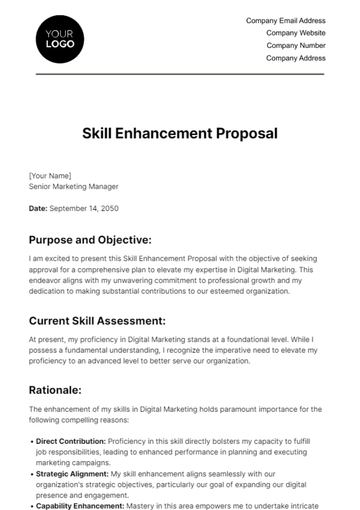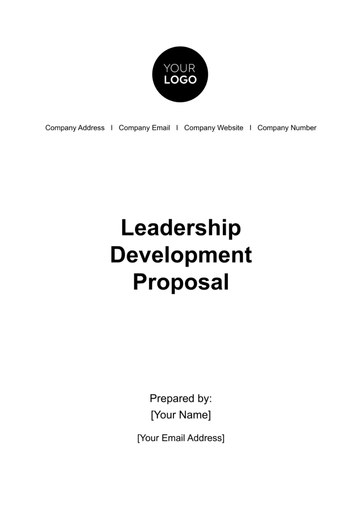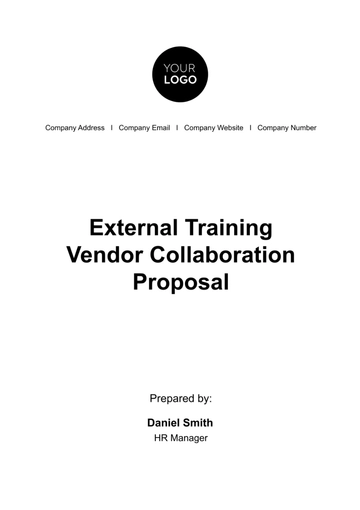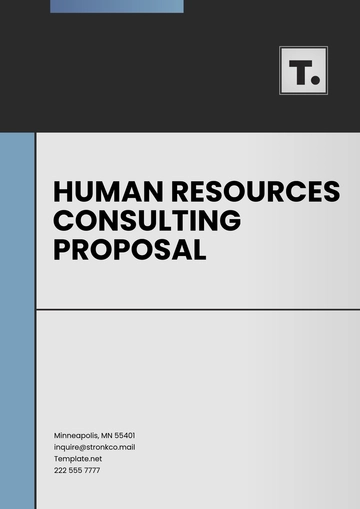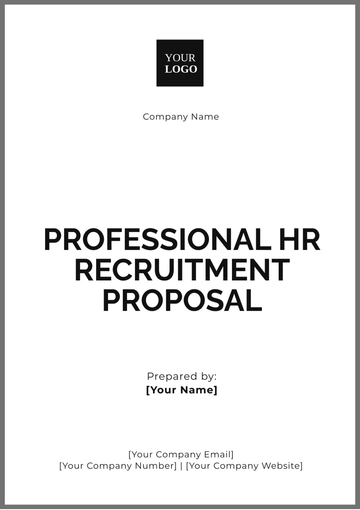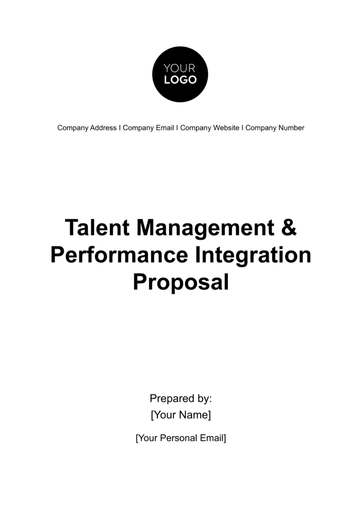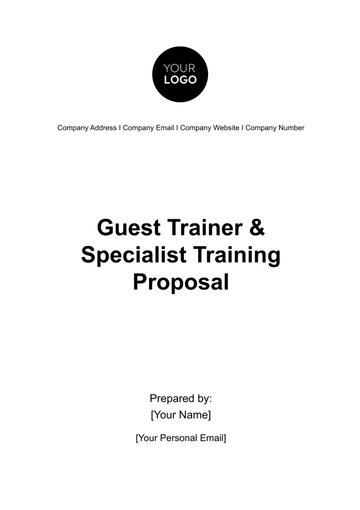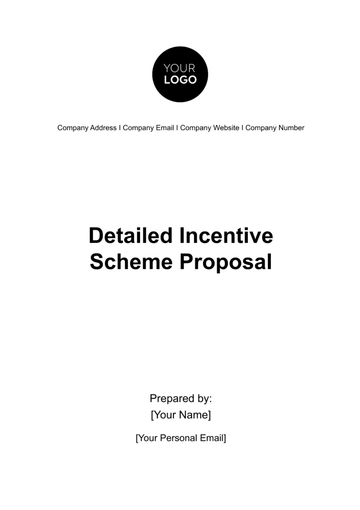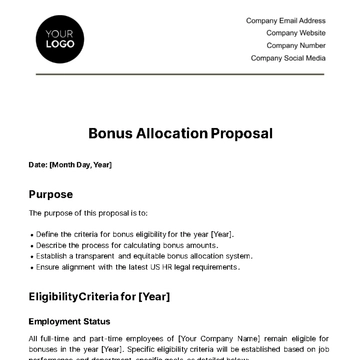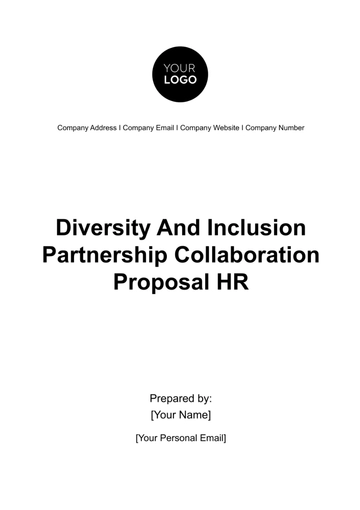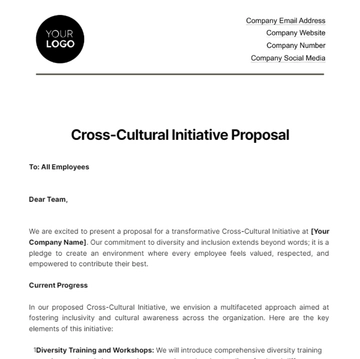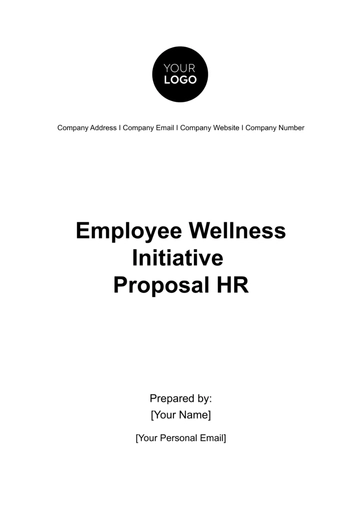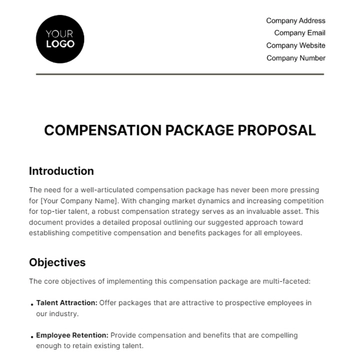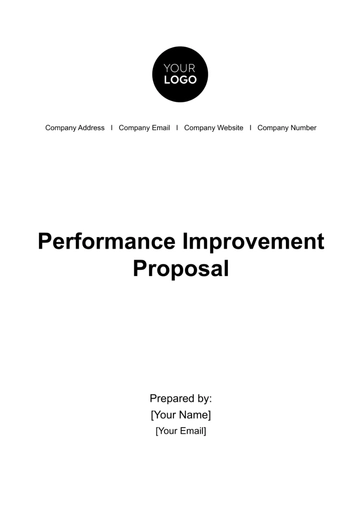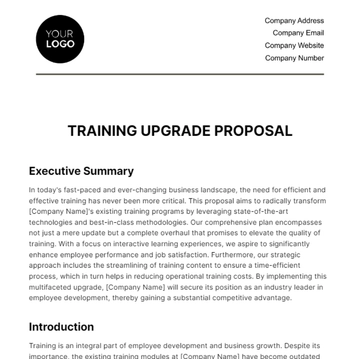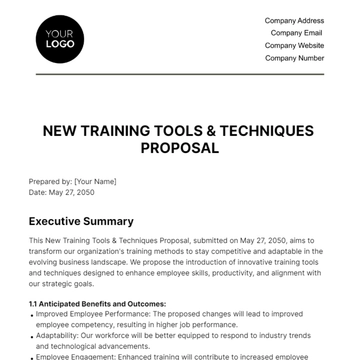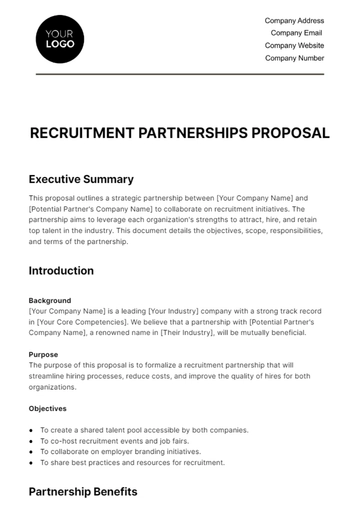Free New Training Tools & Techniques Proposal HR
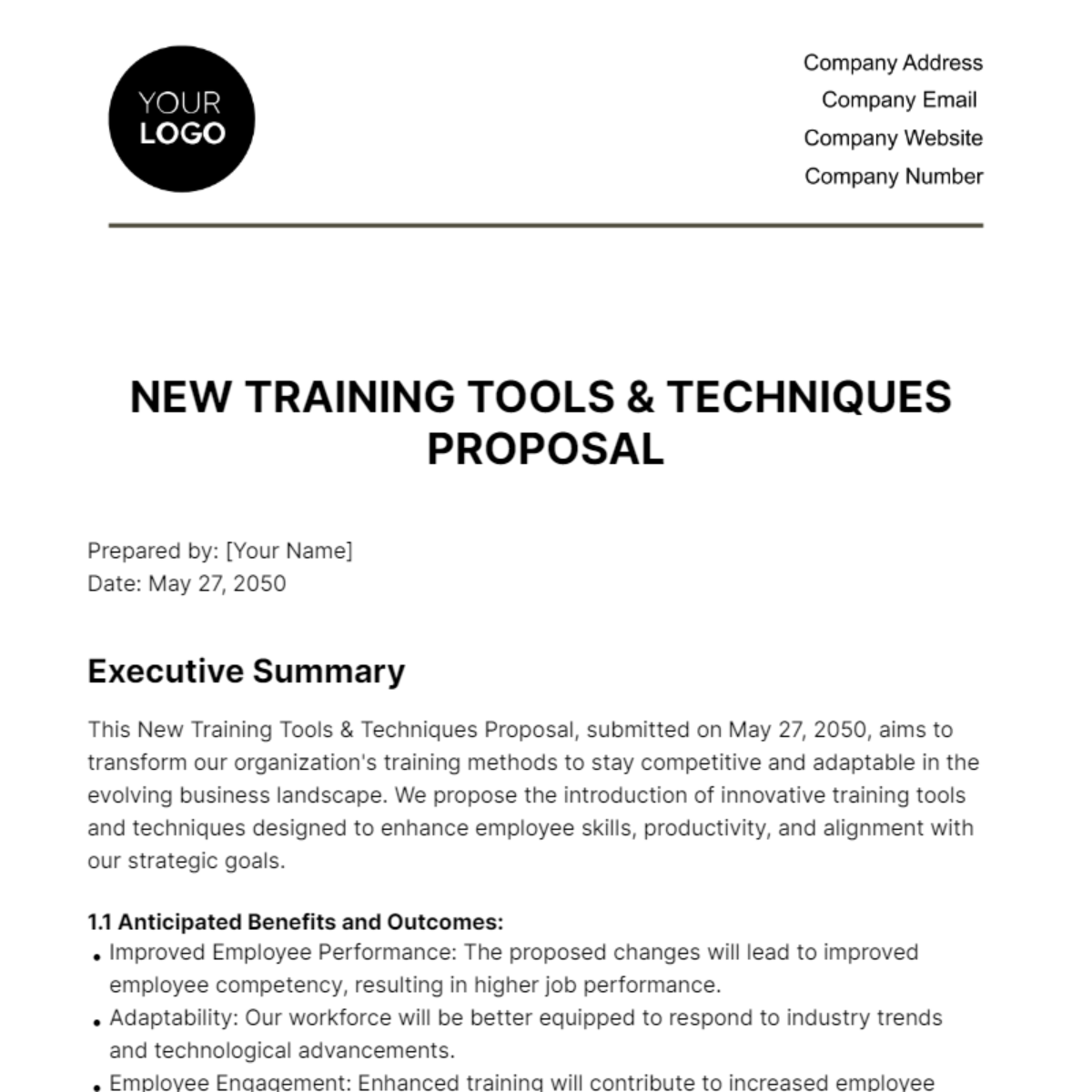
Prepared by: [Your Name]
Date: May 27, 2050
Executive Summary
This New Training Tools & Techniques Proposal, submitted on May 27, 2050, aims to transform our organization's training methods to stay competitive and adaptable in the evolving business landscape. We propose the introduction of innovative training tools and techniques designed to enhance employee skills, productivity, and alignment with our strategic goals.
1.1 Anticipated Benefits and Outcomes:
Improved Employee Performance: The proposed changes will lead to improved employee competency, resulting in higher job performance.
Adaptability: Our workforce will be better equipped to respond to industry trends and technological advancements.
Employee Engagement: Enhanced training will contribute to increased employee engagement and job satisfaction.
Strategic Alignment: Training initiatives will align closely with our long-term organizational goals.
Productivity Boost: Anticipate a measurable increase in productivity and overall performance.
This proposal outlines a comprehensive plan for the development and implementation of these new training tools and techniques, emphasizing their potential to drive our organization's success.
Introduction
2.1 Current Training Methods
Our organization currently relies primarily on traditional classroom-based training and occasional on-the-job training sessions. While these methods have been effective, they now face several challenges:
Limited Scalability: Classroom training is challenging to scale, particularly for large or remote teams.
Lack of Continuous Learning: Opportunities for ongoing skill development and learning are limited.
Adaptation Challenges: Our methods struggle to adapt to remote work and changes in the industry.
Slow Response: The current training framework is not agile enough to respond rapidly to emerging industry trends.
Recent statistics indicate that competitors have already embraced modern training methods, resulting in a 20% increase in productivity and a 15% reduction in employee turnover within the last two years.
2.2 Rationale for Change
To maintain competitiveness and adaptability, it is essential that we evolve our training methods:
Skill Relevance: Ensure our workforce possesses the latest skills and knowledge required for their roles.
Learning Culture: Foster a culture of continuous learning and development.
Agility: Enable rapid response to industry shifts, giving us a competitive edge.
The proposed changes are an investment in our employees and a strategic move to secure our position as an industry leader.
Goals and Objectives
3.1 Goals
Goal 1: Enhance Workforce Competency | |
|
Goal 2: Foster Continuous Learning | |
|
Goal 3: Adaptability to Industry Changes | |
|
3.2 Objectives
Objective 1: Develop Customized E-Learning Modules | |
|
Objective 2: Implement AI-Powered Skill Assessments | |
|
Objective 3: Establish Learning Pathways | |
|
Objective 4: Rapid Response Training | |
|
Methodology
4.1 Training Methods and Techniques
We propose a multifaceted approach to training that leverages a variety of methods and techniques designed to align with our goals and objectives:
E-Learning Platforms: We will implement state-of-the-art e-learning platforms that offer interactive and engaging training modules. These platforms will allow employees to access training materials remotely, fostering a culture of continuous learning. The choice of e-learning aligns with our goal to enhance competency and adaptability.
Workshops and Webinars: In addition to e-learning, we will conduct workshops and webinars, both in-person and virtual, to facilitate collaborative learning experiences. Workshops will focus on hands-on skill development, while webinars will provide insights into industry trends. These methods align with our commitment to fostering continuous learning.
Mentorship Programs: To ensure knowledge transfer and skill enhancement, we will introduce mentorship programs. Experienced employees will mentor newer team members, fostering skills development and a sense of community.
The innovative aspect of our proposed training techniques lies in the integration of AI-driven assessments and personalized learning paths. This adaptive approach ensures that each employee receives training tailored to their needs, accelerating skill development and aligning with our adaptability goal.
Budget
5.1 Budget Overview
The proposed budget for this training initiative is estimated at $750,000. This budget encompasses various categories essential for successful implementation:
Personnel: $300,000: Funding for the training team, including instructional designers, trainers, and support staff.
Technology: $150,000: Investment in learning management systems, AI assessment tools, and content development software.
Materials: $100,000: Costs associated with the creation and distribution of training materials.
Miscellaneous Expenses: $200,000: Budget set aside for unforeseen expenses and contingencies.
5.2 Funding Sources
The funding for this project will primarily be covered by [Your Company Name]. We are committed to investing in our employees' growth and ensuring our organization's future success. Additionally, we are exploring opportunities for external grants and partnerships to supplement the budget.
5.3 Budget Details
The detailed breakdown of expenses within each major category is as follows:
Personnel | |
Salaries and Wages: | $220,000 |
Training Team Support: | $80,000 |
Technology | |
Learning Management System (LMS): | $60,000 |
AI Assessment Tools: | $40,000 |
Content Development Software: | $50,000 |
Materials | |
Content Creation Costs: | $70,000 |
Printing and Distribution: | $30,000 |
Miscellaneous Expenses | |
This category covers various contingency and unforeseen expenses. | $200,000 |
Cost estimates, quotes, and vendor proposals have been included in the detailed
budget plan to ensure transparency and accountability.
Timeline
6.1 Project Timeline
Our project timeline outlines the major phases and milestones for the development and implementation of the new training tools and techniques. Please note that this timeline is subject to adjustment based on project progress and unforeseen circumstances.
Phase 1: Needs Assessment and Planning |
|
Phase 2: Content Development |
|
Phase 3: Technology Integration |
|
Phase 4: Pilot Testing |
|
Phase 5: Full Implementation |
|
Phase 6: Evaluation and Feedback |
|
Phase 7: Ongoing Improvement |
|
Expected Outcomes
7.1 Anticipated Benefits
The implementation of the proposed training methods is expected to yield several significant benefits for our organization:
Enhanced Competency: Employees will acquire up-to-date skills and knowledge, leading to improved job performance and higher quality work.
Adaptability: With a workforce well-prepared to respond to industry changes, we will maintain our competitive edge in a rapidly evolving business environment.
Employee Engagement: The introduction of innovative training tools and techniques will foster a culture of continuous learning, increasing employee engagement and job satisfaction.
Strategic Alignment: Our training initiatives will closely align with our long-term organizational goals, ensuring that our workforce is geared towards achieving our strategic objectives.
7.2 Employee Development
The proposed training will provide numerous opportunities for professional development and skill enhancement:
Tailored Learning: Employees will benefit from personalized learning paths, addressing their specific needs and career goals.
Mentorship Programs: Mentorship opportunities will enable employees to tap into the expertise of experienced colleagues, promoting knowledge transfer and skill development.
7.3 Organizational Performance
Improved training methods are poised to positively impact our overall organizational performance and productivity:
Efficiency Gains: As employees become more skilled and proficient, we anticipate efficiency gains in various operational aspects.
Reduced Turnover: Enhanced training and development opportunities are likely to reduce employee turnover, preserving institutional knowledge and reducing recruitment costs.
Evaluation and Measurement
8.1 Key Performance Indicators (KPIs)
To measure the success of our training program, we will monitor the following KPIs:
Competency Improvement: Measurement of improved employee competency, with a target of achieving a 25% increase by 2055.
Training Participation: Tracking the percentage of employees participating in training programs, aiming for 90% participation by 2055.
Skill Gap Reduction: Assessment of skill gap reductions, with a goal of achieving a 15% reduction within two years.
8.2 Assessment Methods
To evaluate the effectiveness of our training methods, we will employ the following assessment methods:
Surveys: Regular surveys will gather employee feedback on training content, delivery, and relevance.
Quizzes and Assessments: Periodic quizzes and assessments will measure knowledge retention and skill improvement.
Feedback Mechanisms: Continuous feedback mechanisms will be in place to collect real-time input from employees regarding their training experiences.
Performance Metrics: Ongoing tracking of performance metrics related to job tasks and responsibilities, including pre- and post-training comparisons.
Assessments will be conducted regularly to ensure that the training methods remain effective and align with our objectives.
Risks and Challenges
9.1 Risk Assessment
Identifying potential risks is crucial to the success of our training initiative. Some of the identified risks include:
Budget Constraints: The budget allocated for this project may face unexpected constraints due to economic fluctuations or unforeseen expenses.
Technical Issues: Technical challenges related to software integration or hardware failures could disrupt the training process.
Resistance to Change: Employees may initially resist adopting new training methods, potentially impacting participation and engagement.
9.2 Mitigation Strategies
We have developed mitigation strategies and contingency plans to address these identified risks:
Budget Constraints: Regular budget reviews and financial oversight will help identify and address any budget constraints promptly.
Technical Issues: We will work closely with our IT team to proactively identify and resolve technical issues, ensuring minimal disruption.
Resistance to Change: A robust change management plan, including communication and training, will help employees embrace and adapt to the new training methods.
Each risk has been assigned a responsible party for monitoring and managing, and we are committed to taking swift action if any risk materializes.
Conclusion
In conclusion, this proposal represents a critical step forward in enhancing our organization's training methods to meet the evolving demands of the business landscape. Our primary goals and objectives, aimed at improving competency, fostering continuous learning, and enhancing adaptability, are paramount to our long-term success.
The anticipated benefits, including improved employee performance, heightened engagement, and strategic alignment, underscore the significance of this initiative. As we invest in our employees' development, we are simultaneously investing in the future prosperity of our organization.
We urge you to consider the compelling case presented in this proposal and grant your approval for the implementation of these new training tools and techniques. By doing so, we ensure that our workforce remains at the forefront of innovation and competitiveness, ultimately securing our position as an industry leader.
Appendices
In the appendices section, you will find a collection of supporting documents and materials that further enhance the proposal's credibility and provide additional insights:
Sample Training Materials: Attached are samples of the proposed training content, offering a glimpse into the quality and effectiveness of our training materials.
Budget Breakdown: A detailed breakdown of the budget, including cost estimates, quotes, and vendor proposals, is included for your reference.
Project Timeline: A visual representation of the project timeline, highlighting key phases and milestones, is provided to facilitate project management.
Risk Assessment Matrix: A matrix outlining identified risks, their severity, and mitigation strategies is included to ensure comprehensive risk management.
These appendices serve to provide a comprehensive view of our proposal, offering data-driven insights and tangible evidence of the potential success of this initiative.
- 100% Customizable, free editor
- Access 1 Million+ Templates, photo’s & graphics
- Download or share as a template
- Click and replace photos, graphics, text, backgrounds
- Resize, crop, AI write & more
- Access advanced editor
Revolutionize your training strategies in no time using our New Training Tools & Techniques Proposal HR Template available at Template.net. Streamline your proposal process with ready-made sections for methodology, budget, timeline, and more. Craft compelling proposals for innovative training methods, ensuring organizational growth and employee development. Elevate your training game today.
You may also like
- Business Proposal
- Research Proposal
- Proposal Request
- Project Proposal
- Grant Proposal
- Photography Proposal
- Job Proposal
- Budget Proposal
- Marketing Proposal
- Branding Proposal
- Advertising Proposal
- Sales Proposal
- Startup Proposal
- Event Proposal
- Creative Proposal
- Restaurant Proposal
- Blank Proposal
- One Page Proposal
- Proposal Report
- IT Proposal
- Non Profit Proposal
- Training Proposal
- Construction Proposal
- School Proposal
- Cleaning Proposal
- Contract Proposal
- HR Proposal
- Travel Agency Proposal
- Small Business Proposal
- Investment Proposal
- Bid Proposal
- Retail Business Proposal
- Sponsorship Proposal
- Academic Proposal
- Partnership Proposal
- Work Proposal
- Agency Proposal
- University Proposal
- Accounting Proposal
- Real Estate Proposal
- Hotel Proposal
- Product Proposal
- Advertising Agency Proposal
- Development Proposal
- Loan Proposal
- Website Proposal
- Nursing Home Proposal
- Financial Proposal
- Salon Proposal
- Freelancer Proposal
- Funding Proposal
- Work from Home Proposal
- Company Proposal
- Consulting Proposal
- Educational Proposal
- Construction Bid Proposal
- Interior Design Proposal
- New Product Proposal
- Sports Proposal
- Corporate Proposal
- Food Proposal
- Property Proposal
- Maintenance Proposal
- Purchase Proposal
- Rental Proposal
- Recruitment Proposal
- Social Media Proposal
- Travel Proposal
- Trip Proposal
- Software Proposal
- Conference Proposal
- Graphic Design Proposal
- Law Firm Proposal
- Medical Proposal
- Music Proposal
- Pricing Proposal
- SEO Proposal
- Strategy Proposal
- Technical Proposal
- Coaching Proposal
- Ecommerce Proposal
- Fundraising Proposal
- Landscaping Proposal
- Charity Proposal
- Contractor Proposal
- Exhibition Proposal
- Art Proposal
- Mobile Proposal
- Equipment Proposal
- Student Proposal
- Engineering Proposal
- Business Proposal
